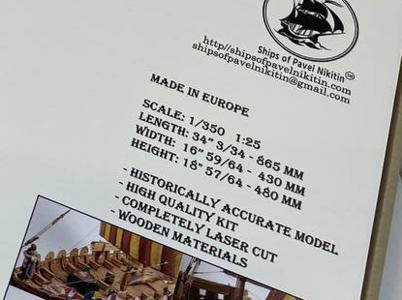What a GORGEOUS kit! Pavel, it's simply amazing.
-

Win a Free Custom Engraved Brass Coin!!!
As a way to introduce our brass coins to the community, we will raffle off a free coin during the month of August. Follow link ABOVE for instructions for entering.
You are using an out of date browser. It may not display this or other websites correctly.
You should upgrade or use an alternative browser.
You should upgrade or use an alternative browser.
- Joined
- Jul 18, 2019
- Messages
- 409
- Points
- 323

Overall dimensions of the constructed model of the "Oseberg" dracar on a scale of 1:25. Length 865 mm. Width 430 mm. Height 480 mm.THAT IS GREAT PAVEL COULD YOU TELL ME THE LENGTH OF THE NEW OSBERG PLEASE ANOTHER ONE FROM UKRAINE. GOD BLESS STAY SAFE YOU AND YOURS DON
- Joined
- Oct 12, 2019
- Messages
- 151
- Points
- 88

Hi Pavel,
I'm in for one of the Oseburg ships too!
I'm in for one of the Oseburg ships too!
HI PAVEL, IWOULD LIKE TO KNOW WHAT THE DIFFERENCE BETWEEN THE ORIGANAL AND UPGRADE IS AND APPROXIMATE COST. IF NOT TO GREAT AND THE SIZE IS THE SAME IS ONE OF THE OLDER VERSIONS STILL AVAILABLE. GOD BLESS STAY SAFE YOU AND YOURS DON
- Joined
- Jul 18, 2019
- Messages
- 409
- Points
- 323

The old version is still available. Differences between the old version and the new one in everything. Keel, frames, cutting boards, decks, spars, sails, there is practically not a single element that would not have received its development. Outwardly, both built versions are practically indistinguishable. But inside, these are completely different approaches to the design of the drakar. The first version was released almost three years ago, and I was sure that it would not need to be finalized, but over time, many new ideas appeared on how to make the construction of the mozhelist easier, and from these ideas a new version appeared) In three weeks I will start publishing photos of the construction stages new "Oseberg", and everything I wrote about can be seen for yourself)HI PAVEL, IWOULD LIKE TO KNOW WHAT THE DIFFERENCE BETWEEN THE ORIGANAL AND UPGRADE IS AND APPROXIMATE COST. IF NOT TO GREAT AND THE SIZE IS THE SAME IS ONE OF THE OLDER VERSIONS STILL AVAILABLE. GOD BLESS STAY SAFE YOU AND YOURS DON
I cannot begin to understand Amati’s design choices…simply saying it is a commonly available kit…Thanks for your reply. I want to build an authentic Viking ship, not some fantasy monster with Chinese dragon heads.
- Joined
- Jul 18, 2019
- Messages
- 409
- Points
- 323

The decisions Amati makes can be difficult to understand. I think it's just business for them. And if there is a choice between truthful reproduction and profit, then the latter is most often chosen.I cannot begin to understand Amati’s design choices…simply saying it is a commonly available kit…
- Joined
- Oct 23, 2018
- Messages
- 863
- Points
- 403

Hi Pavel,
it is very sad, that you will use another scale for the Gokstad ship. In my opinion 1/25 is a really good if not perfect scale for a private modeller to built this kind of vessels. The only advantage of 1/32 are the figures, that are available to built a small diorama with such a boat.
it is very sad, that you will use another scale for the Gokstad ship. In my opinion 1/25 is a really good if not perfect scale for a private modeller to built this kind of vessels. The only advantage of 1/32 are the figures, that are available to built a small diorama with such a boat.
- Joined
- Jul 18, 2019
- Messages
- 409
- Points
- 323

HiHi Pavel,
it is very sad, that you will use another scale for the Gokstad ship. In my opinion 1/25 is a really good if not perfect scale for a private modeller to built this kind of vessels. The only advantage of 1/32 are the figures, that are available to built a small diorama with such a boat.
The fact is that the scale of the model that we use in the manufacture of the kit is a convention dictated by the market. If there is a steady demand for a new set, it will not be difficult to release it on a larger scale. It's just a matter of time, because absolutely all the elements of the ship are already drawn in vectors, and increasing or decreasing them is a purely technical moment. Below I show an example of computer development of the new "Oseber"
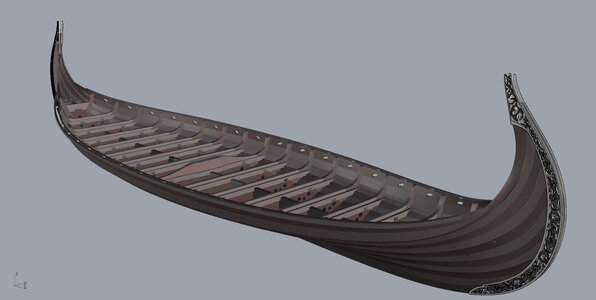
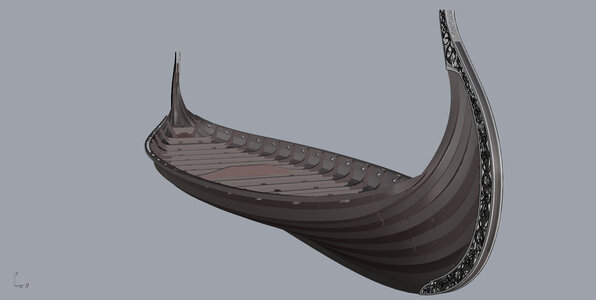
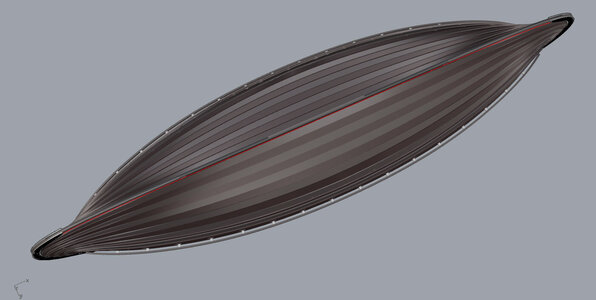
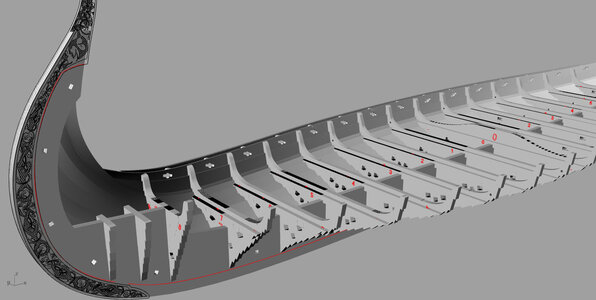
I built the large scale Billings model and do not understand the criticism of the quality of the timber. Most of the kit parts comprise the planking which is pre-cut plywood and, if care is taken when setting each plank so the plank spacing is correct, it produces a perfect replica. I hate to say it but there are excellent build logs of this kit on "the other channel".
They may possibly have upgraded the planks, the two I have are admittedly old but it is practically balsa. Either way I've checked out Pavel's and it's 5 times the quality and a damn sight cheaper.
the planks are very good quality birch ply, about 1mm thick.
I like the look of the Drakkar model, the scale makes it more manageable for display and it appears to be very similar to the Billings 1/25 kit, with the notable and welcome exception that the frames are built up from solid wood (or so i believe) while Billings has plywood frames that need a lot of staining to disguise the plies. Which begs the question - should the model be stained dark oak and the deck planks laid loose and uneven, to replicate the museum ship, or is it preferable to finish it as if it is newly built and seagoing? AFAIK the Oseberg was only built as a burial ship and never went to sea. The depth of the hull suggests that it might easily be swamped on a transatlantic voyage to the fishing grounds of eastern Canada or Iceland.
- Joined
- Feb 15, 2019
- Messages
- 377
- Points
- 168

Personally I'd make it shipshape. What sort of stain? Colron usually requires a couple of coats and the dark oak has too much black in the mix. I blend colours until I'm satisfied. As always, do test runs. It would make sense to use darker tones, no doubt they were heavily tarred.the planks are very good quality birch ply, about 1mm thick.
I like the look of the Drakkar model, the scale makes it more manageable for display and it appears to be very similar to the Billings 1/25 kit, with the notable and welcome exception that the frames are built up from solid wood (or so i believe) while Billings has plywood frames that need a lot of staining to disguise the plies. Which begs the question - should the model be stained dark oak and the deck planks laid loose and uneven, to replicate the museum ship, or is it preferable to finish it as if it is newly built and seagoing? AFAIK the Oseberg was only built as a burial ship and never went to sea. The depth of the hull suggests that it might easily be swamped on a transatlantic voyage to the fishing grounds of eastern Canada or Iceland.
BOY USING PLY FOR FRAMES IS A NO GO FOR ME, MY OPION NO MATTER WHAT I DO I CAN NOT GET A STAIN ON PLY WORTH ANYTHING MAYBE JUST ME. GOD BLESS STAY SAFE ALL DON
- Joined
- Jul 18, 2019
- Messages
- 409
- Points
- 323

In our new drakar, the keel is made of wood, specifically walnut, so you don’t have to paint it much. Only frames are made of plywood, and then only the part that is in the hold. Everything that is visible is only made of wood. Here is the composition of each frame, only the lower main part is made of plywood. Everything else is made of wood, taking into account the direction of the wood texture.the planks are very good quality birch ply, about 1mm thick.
I like the look of the Drakkar model, the scale makes it more manageable for display and it appears to be very similar to the Billings 1/25 kit, with the notable and welcome exception that the frames are built up from solid wood (or so i believe) while Billings has plywood frames that need a lot of staining to disguise the plies. Which begs the question - should the model be stained dark oak and the deck planks laid loose and uneven, to replicate the museum ship, or is it preferable to finish it as if it is newly built and seagoing? AFAIK the Oseberg was only built as a burial ship and never went to sea. The depth of the hull suggests that it might easily be swamped on a transatlantic voyage to the fishing grounds of
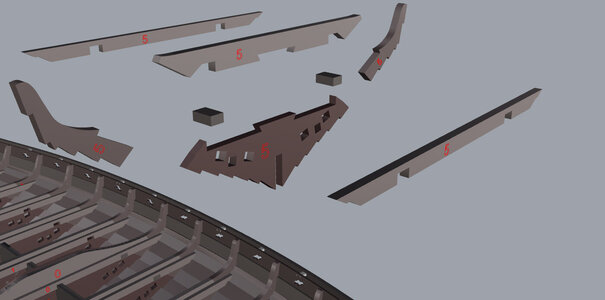
Last edited:
THAT IS THE WAY TO DO IT GREAT MODEL ENGINEERING,ON MY LIST DEFINATLY. GOD BLESS STAY SAFE ALL DON
- Joined
- Jul 18, 2019
- Messages
- 409
- Points
- 323

In our new drakar, the keel is made of wood, specifically walnut, so you don’t have to paint it much. Only frames are made of plywood, and then only the part that is in the hold. Everything that is visible is only made of wood. Here is the composition of each frame, only the lower main part is made of plywood.
And here is the design of the keel. All parts from 2 mm walnut plate. When assembled to a full keel, this will give a total of 4 mm. And the keel itself will turn out to be even and very hard.
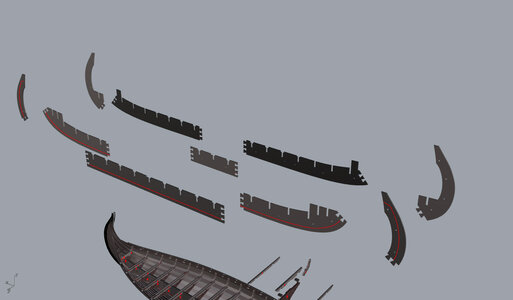
And here is the design of the keel. All parts from 2 mm walnut plate. When assembled to a full keel, this will give a total of 4 mm. And the keel itself will turn out to be even and very hard.

- Joined
- Jul 18, 2019
- Messages
- 409
- Points
- 323

This is my not sufficiently accurate knowledge of the correct spelling of the scale in inches)) In Europe, the metric system of measurements is common, unfortunately I still did not fully understand how to translate the length and scale into inches.Speaking of scale, the Oseberg box says the scale is 1/25 (which I know to be correct) but also 1/350. Is this just an error, or does it mean something else?
- Joined
- Oct 23, 2018
- Messages
- 863
- Points
- 403

Pavel,
1/25 is a metric scale. For 1/25 is no inch per feet scale common.
1/24 or 1/2 inch per feet is a similiar british scale. 1/2 * 1/12 (1foot = 12 inch) = 1/24
1/25 is a metric scale. For 1/25 is no inch per feet scale common.
1/24 or 1/2 inch per feet is a similiar british scale. 1/2 * 1/12 (1foot = 12 inch) = 1/24
No, I don't care about the inches and fractions, they're easy to calculate. I was referring to the two different scales on the box, 1/25 being correct, 1/350 obviously no:This is my not sufficiently accurate knowledge of the correct spelling of the scale in inches)) In Europe, the metric system of measurements is common, unfortunately I still did not fully understand how to translate the length and scale into inches.
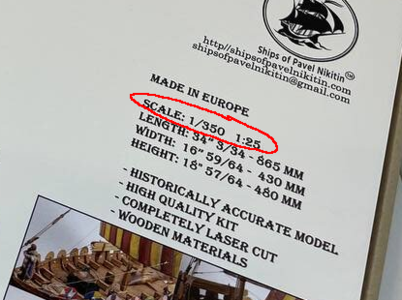
It's not important, though, really. I was just curious.
- Joined
- Jul 18, 2019
- Messages
- 409
- Points
- 323

Yes, that's exactly what I meant, I did not understand the inch scale, and 1/350 is most likely not correct.No, I don't care about the inches and fractions, they're easy to calculate. I was referring to the two different scales on the box, 1/25 being correct, 1/350 obviously no:



